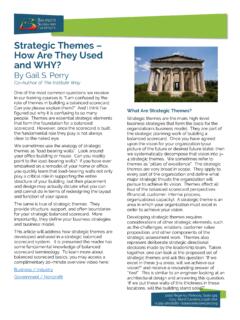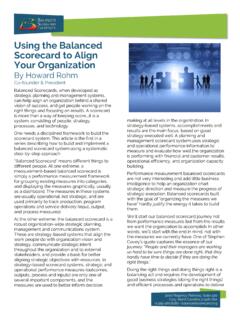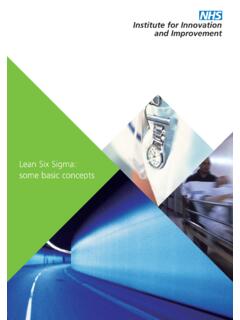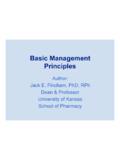Transcription of CAUSE-AND-EFFECT DIAGRAM
1 Basic Tools for Process ImprovementCAUSE-AND- effect DIAGRAM1 Module 5 CAUSE-AND-EFFECTDIAGRAMB asic Tools for Process Improvement2 CAUSE-AND-EFFECT DIAGRAMWhat is a CAUSE-AND-EFFECT DIAGRAM ?A CAUSE-AND-EFFECT DIAGRAM is a tool that helps identify, sort, and display possiblecauses of a specific problem or quality characteristic (Viewgraph 1). It graphicallyillustrates the relationship between a given outcome and all the factors that influencethe outcome. This type of DIAGRAM is sometimes called an "Ishikawa DIAGRAM "because it was invented by Kaoru Ishikawa, or a "fishbone DIAGRAM " because of theway it should a team use a CAUSE-AND-EFFECT DIAGRAM ?
2 Constructing a CAUSE-AND-EFFECT DIAGRAM can help your team when you need to !Identify the possible root causes , the basic reasons, for a specific effect ,problem, or condition.!Sort out and relate some of the interactions among the factors affecting aparticular process or effect .!Analyze existing problems so that corrective action can be should we use a CAUSE-AND-EFFECT DIAGRAM ?A CAUSE-AND-EFFECT DIAGRAM is a tool that is useful for identifying and organizing theknown or possible causes of quality, or the lack of it. The structure provided by thediagram helps team members think in a very systematic way. Some of the benefitsof constructing a CAUSE-AND-EFFECT DIAGRAM (Viewgraphs 2) are that it!
3 Helps determine the root causes of a problem or quality characteristicusing a structured approach.!Encourages group participation and utilizes group knowledge of theprocess.!Uses an orderly, easy-to-read format to DIAGRAM cause-and-effectrelationships.!Indicates possible causes of variation in a process.!Increases knowledge of the process by helping everyone to learn moreabout the factors at work and how they relate.!Identifies areas where data should be collected for further DIAGRAMVIEWGRAPH 1 What Is a Cause-and-EffectDiagram?A graphic tool that helps identify,sort, and display possible causes ofa problem or quality DIAGRAMVIEWGRAPH 2 Benefits of Usinga CAUSE-AND-EFFECT DIAGRAM Helps determine root causes Encourages group participation Uses an orderly, easy-to-read format Indicates possible causes of variation Increases process knowledge Identifies areas for collecting dataBasic Tools for Process ImprovementCAUSE-AND- effect DIAGRAM3 Basic Tools for Process Improvement4 CAUSE-AND-EFFECT DIAGRAMHow do we develop a CAUSE-AND-EFFECT DIAGRAM ?
4 When you develop a CAUSE-AND-EFFECT DIAGRAM , you are constructing a structured,pictorial display of a list of causes organized to show their relationship to a specificeffect. Viewgraph 3 shows the basic layout of a CAUSE-AND-EFFECT DIAGRAM . Noticethat the DIAGRAM has a cause side and an effect side. The steps for constructing andanalyzing a CAUSE-AND-EFFECT DIAGRAM are outlined 1 - Identify and clearly define the outcome or effect to be analyzed (Viewgraph 4).!Decide on the effect to be examined. Effects are stated as particular qualitycharacteristics, problems resulting from work, planning objectives, and the like.!Use Operational Definitions.
5 Develop an Operational Definition of the effect toensure that it is clearly understood.!Remember, an effect may be positive (an objective) or negative (a problem),depending upon the issue that s being discussed. >Using a positive effect which focuses on a desired outcome tends to fosterpride and ownership over productive areas. This may lead to an upbeatatmosphere that encourages the participation of the group. When possible,it is preferable to phrase the effect in positive terms.>Focusing on a negative effect can sidetrack the team into justifying why theproblem occurred and placing blame. However, it is sometimes easier fora team to focus on what causes a problem than what causes an excellentoutcome.
6 While you should be cautious about the fallout that can resultfrom focusing on a negative effect , getting a team to concentrate on thingsthat can go wrong may foster a more relaxed atmosphere and sometimesenhances group participation. You must decide which approach will work best with your : The EXAMPLE that is imbedded in the explanation of Cause-and-EffectDiagram construction and analysis on the next few pages is based on a chart inThe Memory Jogger [Ref. 1, p. 28]. This DIAGRAM has been broken down into itscomponent parts and expanded to illustrate the construction steps. Using thisexample, we will DIAGRAM the causes relating to a car s getting poor gas DIAGRAMVIEWGRAPH 3 Basic Layout ofCause-and- effect DiagramsCAUSE ACAUSE DCAUSE CCAUSE BEFFECTCAUSE-AND- effect DIAGRAMVIEWGRAPH 4 Step 1 - Identify and Define the effect Decide on the effect to examine Use Operational Definitions Phrase effect as>positive (an objective) or>negative (a problem)Basic Tools for Process ImprovementCAUSE-AND- effect DIAGRAM5 Basic Tools for Process Improvement6 CAUSE-AND-EFFECT DIAGRAMStep 2 - Using a chartpack positioned so that everyone can see it, draw the SPINE and create the effect box.
7 !Draw a horizontal arrow pointing to the right. This is the spine.!To the right of the arrow, write a brief description of the effect or outcomewhich results from the : The effect is Poor Gas Mileage (Viewgraph 5).!Draw a box around the description of the 3 - Identify the main causes contributing to the effect being studied. These are the labels for the major branches of your DIAGRAM and becomecategories under which to list the many causes related to those categories.!Establish the main causes , or categories, under which other possible causeswill be listed. You should use category labels that make sense for the diagramyou are creating. Here are some commonly used categories:>3Ms and P - methods, materials, machinery, and people>4Ps - policies, procedures, people, and plant>Environment - a potentially significant fifth category!
8 Write the main categories your team has selected to the left of the effect box,some above the spine and some below it.!Draw a box around each category label and use a diagonal line to form abranch connecting the box to the : Viewgraph 6 uses the 3Ms and P to start developing the diagramwe began in Step DIAGRAMVIEWGRAPH 5 Step 2 - Fill in the effect Box andDraw the SpinePOORGASMILEAGECAUSE-AND- effect DIAGRAMVIEWGRAPH 6 Step 3 - Identify Main CategoriesPOORGASMILEAGEMETHODSMACHINERY PEOPLEMATERIALSB asic Tools for Process ImprovementCAUSE-AND- effect DIAGRAM7 Basic Tools for Process Improvement8 CAUSE-AND-EFFECT DIAGRAMStep 4 - For each major branch, identify other specific factors which may bethe causes of the effect [Ref.]
9 5, p. 20].Identify as many causes or factors as possible and attach them assubbranches of the major : The possible causes for Poor Gas Mileage are listed under theappropriate categories in Viewgraph 7:Fill in detail for each cause. If a minor cause applies to more than one majorcause, list it under both. Step 5 - Identify increasingly more detailed levels of causes and continueorganizing them under related causes or categories. You can do this byasking a series of why : We ll use a series of why questions to fill in the detailed levels forone of the causes listed under each of the main : Why was the driver USING THE WRONG GEAR?A: The driver couldn't hear the : Why couldn't the driver hear the engine?
10 A: The radio was too : Poor hearingQ: Why were the TIRES UNDERINFLATED?A: No record of tire pressureA: Difficult air stemsQ: Why were the air stems difficult?A: Poor designQ: Why was MAINTENANCE POOR?A: Lack of moneyA: No awarenessQ: Why was WRONG OCTANE GAS used?A: Didn t know recommended octaneQ: Why wasn t recommended octane known?A: No owner's manualViewgraph 8 shows how the DIAGRAM looks when all the contributing causes thatwere identified by the series of why questions have been filled in. As you cansee, there may be many levels of causes contributing to the DIAGRAMVIEWGRAPH 7 Step 4 - Identify causes Influencingthe EffectPOORGASMILEAGEMETHODSMACHINERYPEOP LEMATERIALSDRIVETOO FASTUSE WRONGGEARSCARBURETORADJUSTMENTUNDERINFLA TEDTIRESPOORMAINTENANCEPOORDRIVING HABITSIMPROPERLUBRICATIONWRONGOCTANEGASC AUSE-AND- effect DIAGRAMVIEWGRAPH 8 Step 5 - Add Detailed LevelsStep 6 - Analyze the DiagramALWAYSLATEPOORGASMILEAGEMETHODSMA CHINERYPEOPLEMATERIALSDRIVETOO FASTUSE WRONGGEARSCARBURETORADJUSTMENTUNDERINFLA TEDTIRESPOORDRIVING HABITSIMPROPERLUBRICATIONWRONGOCTANEGASI MPATIENCEPOOR HEARINGRADIO TOOLOUDCAN T HEARENGINE$NOAWARENESSMECH.







